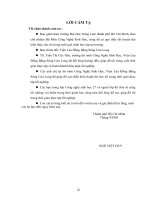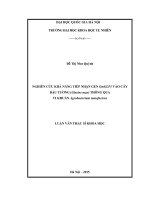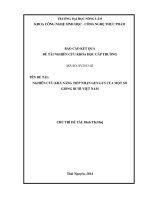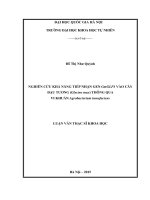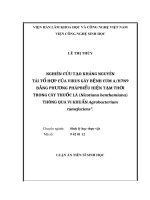Nghiên cứu khả năng tiếp nhận gen GmGLP1 vào cây đậu tương (glycine max) thông qua vi khuẩn agrobacterium tumefaciens
Bạn đang xem bản rút gọn của tài liệu. Xem và tải ngay bản đầy đủ của tài liệu tại đây (631.8 KB, 23 trang )
ĐẠI HỌC QUỐC GIA HÀ NỘI
TRƢỜNG ĐẠI HỌC KHOA HỌC TỰ NHIÊN
------------
Đỗ Thị Nhƣ Quỳnh
NGHIÊN CỨU KHẢ NĂNG TIẾP NHẬN GEN GmGLP1 VÀO CÂY
ĐẬU TƢƠNG (Glycine max) THÔNG QUA
VI KHUẨN Agrobacterium tumefaciens
LUẬN VĂN THẠC SĨ KHOA HỌC
Hà Nội – 2015
ĐẠI HỌC QUỐC GIA HÀ NỘI
TRƢỜNG ĐẠI HỌC KHOA HỌC TỰ NHIÊN
------------
Đỗ Thị Nhƣ Quỳnh
NGHIÊN CỨU KHẢ NĂNG TIẾP NHẬN GEN GmGLP1 VÀO CÂY
ĐẬU TƢƠNG (Glycine max) THÔNG QUA
VI KHUẨN Agrobacterium tumefaciens
Chuyên ngành: Sinh học thực nghiệm
Mã số: 60 42 01 14
LUẬN VĂN THẠC SĨ KHOA HỌC
Ngƣời hƣớng dẫn: PGS. TS. Nguyễn Văn Đồng
TS. Lê Hồng Điệp
Hà Nội – 2015
LỜI CẢM ƠN
Trước tiên, tôi xin bày tỏ lòng biết ơn sâu sắc nhất tới PGS.TS Nguyễn Văn
Đồng – người thầy luôn kiên nhẫn và hết lòng hướng dẫn, giúp đỡ tôi trong suốt
quá trình tôi thực hiện luận văn.
Tôi xin gửi tới TS. Lê Hồng Điệp lời cảm ơn chân thành, người đã luôn hỗ
trợ và giúp đỡ để tôi hoàn thành luận văn.
Tôi cũng xin bày tỏ lòng biết ơn sâu sắc đối với sự giúp đỡ nhiệt tình, những
ý kiến đóng góp quý báu cũng như sự chỉ dẫn tận tình của TS. Nguyễn Anh Vũ
trong suốt quá trình tôi thực hiện và hoàn thành luận văn.
Tôi xin gửi lời cảm ơn tới Kỹ sư Lương Thanh Quang cùng tập thể cán bộ
Phòng Thí nghiệm Trọng điểm Công nghệ Tế bào Thực vật – Viện Di truyền Nông
Nghiệp về sự nhiệt tình giúp đỡ và đã tạo mọi điều kiện tốt nhất để tôi có thể thực
hiện được đề tài này một cách suôn sẻ và thuận lợi.
Cuối cùng, tôi xin gửi tới bố mẹ, anh chị, người thân cùng bạn bè lời cảm ơn
thân thương nhất - những người đã luôn sát cánh, quan tâm và dành cho tôi tình
cảm chân thành trong suốt thời gian tôi học tập và hoàn thành luận văn này cũng
như đã luôn luôn bên cạnh và ủng hộ tôi trong cuộc sống.
Tôi xin chân thành cảm ơn!
Hà Nội, ngày tháng năm 2015
Học viên cao học
Đỗ Thị Như Quỳnh
MỤC LỤC
MỞ ĐẦU ....................................................................................................................1
CHƢƠNG 1 - TỔNG QUAN TÀI LIỆU.................. Error! Bookmark not defined.
1.1. Đậu tƣơng và tầm quan trọng của cây đậu tƣơngError!
Bookmark
not
defined.
1.1.1. Giới thiệu chung về đặc điểm sinh học của cây đậu tƣơng ................. Error!
Bookmark not defined.
1.1.2. Vai trò của cây đậu tƣơng đối với đời sống của con ngƣời ................. Error!
Bookmark not defined.
1.1.3. Tình hình sản xuất đậu tƣơng trên Thế giới và Việt NamError! Bookmark
not defined.
1.2. Cơ chế chống chịu các yếu tố phi sinh học của thực vậtError!
Bookmark
not defined.
1.3. Đặc tính chịu hạn và một số gen liên quan đến khả năng chịu hạn ở cây đậu
tƣơng ...................................................................... Error! Bookmark not defined.
1.3.1. Đặc tính chịu hạn ở cây đậu tƣơng .............. Error! Bookmark not defined.
1.3.2. Các gen liên quan đến khả năng chịu hạn ở cây đậu tƣơng................. Error!
Bookmark not defined.
1.4. Gen GmGLP1 ................................................. Error! Bookmark not defined.
1.5. Các phƣơng pháp chuyển gen vào thực vật .... Error! Bookmark not defined.
1.5.1. Chuyển gen thông qua vi khuẩn Agrobacterium tumefaciens ............. Error!
Bookmark not defined.
1.5.2. Chuyển gen trực tiếp bằng súng bắn gen ..... Error! Bookmark not defined.
1.5.3. Phƣơng pháp chuyển gen bằng xung điện ... Error! Bookmark not defined.
1.5.4. Phƣơng pháp chuyển gen qua ống phấn ...... Error! Bookmark not defined.
1.6. Nguồn gốc và đặc tính sinh học của 4 giống đậu tƣơng ĐT22, ĐVN9, ĐT26
và DT84 ................................................................. Error! Bookmark not defined.
CHƢƠNG 2 - VẬT LIỆU VÀ PHƢƠNG PHÁP ..... Error! Bookmark not defined.
2.1. Địa điểm và thời gian nghiên cứu ................... Error! Bookmark not defined.
2.2. Vật liệu nghiên cứu ......................................... Error! Bookmark not defined.
2.2.1. Vật liệu ......................................................... Error! Bookmark not defined.
2.2.2. Hóa chất và môi trƣờng .............................. Error! Bookmark not defined.
2.2.3. Thiết bị và dụng cụ ...................................... Error! Bookmark not defined.
2.2.4. Trình tự mồi và enzyme cắt giới hạn sử dụng trong nghiên cứu ......... Error!
Bookmark not defined.
2.3. Phƣơng pháp nghiên cứu ................................ Error! Bookmark not defined.
2.3.1. Phƣơng pháp chuyển gen thông qua vi khuẩn A. tumefaciens ........... Error!
Bookmark not defined.
2.3.2. Phƣơng pháp tách chiết DNA tổng số từ mẫu láError!
Bookmark
not
defined.
2.3.3. Phƣơng pháp nhân bản trình tự ADN bằng kỹ thuật PCRError! Bookmark
not defined.
2.3.4. Phƣơng pháp thôi gel và tinh sạch sản phẩm PCRError! Bookmark not
defined.
2.3.5. Phƣơng pháp lai Southern blot .................... Error! Bookmark not defined.
2.4. Các tiêu chí đánh giá....................................... Error! Bookmark not defined.
CHƢƠNG 3 - KẾT QUẢ VÀ THẢO LUẬN.......... Error! Bookmark not defined.
3.1. Kết quả đánh giá khả năng tái sinh cây hoàn chỉnh của 4 giống đậu tƣơng
ĐT22, ĐVN9, ĐT26 và DT84 ............................... Error! Bookmark not defined.
3.1.1. Đánh giá nguồn vật liệu khởi đầu ................ Error! Bookmark not defined.
3.1.2. Khả năng tái sinh tạo đa chồi ....................... Error! Bookmark not defined.
3.1.3. Khả năng tái sinh rễ tạo cây hoàn chỉnh ...... Error! Bookmark not defined.
3.2.2. Kiểm tra sự có mặt của gen cần chuyển GmGLP1 bằng kỹ thuật PCR
............................................................................... Error! Bookmark not defined.
3.3. Phân tích cây chuyển gen ở thế hệ T1 ............. Error! Bookmark not defined.
KẾT LUẬN VÀ KIẾN NGHỊ................................... Error! Bookmark not defined.
KẾT LUẬN ............................................................... Error! Bookmark not defined.
TÀI LIỆU THAM KHẢO ...........................................................................................3
PHỤ LỤC .................................................................. Error! Bookmark not defined.
DANH MỤC BẢNG
Bảng 1. Tình hình sản xuất đậu tƣơng trên Thế giới trong những năm gần đây
............................................................................ Error! Bookmark not defined.
Bảng 2. Tình hình sản xuất đậu tƣơng của 4 nƣớc đứng đầu trên Thế giới
............................................................................ Error! Bookmark not defined.
trong những năm gần đây ................................... Error! Bookmark not defined.
Bảng 3. Tình hình sản xuất đậu tƣơng ở Việt Nam trong những năm gần đây
............................................................................ Error! Bookmark not defined.
Bảng 4. Trình tự cặp mồi sử dụng trong thí nghiệm ........ Error! Bookmark not
defined.
Bảng5. Thành phần phản ứng PCR .................... Error! Bookmark not defined.
Bảng 6. Chu trình nhiệt của phản ứng PCR ....... Error! Bookmark not defined.
Bảng 7. Thành phần phản ứng cắt giới hạn bằng enzyme Bam HI ............ Error!
Bookmark not defined.
Bảng8. Kết quả khảo sát tỷ lệ này mầm của 4 giống đậu tƣơng ................ Error!
Bookmark not defined.
ĐT22, ĐT26, ĐVN9, DT84 ............................... Error! Bookmark not defined.
Bảng 9. Khả năng phát sinh chồi của 4 giống đậu tƣơng nghiên cứu sau 14 ngày
............................................................................ Error! Bookmark not defined.
Bảng 10. Khả năng sống sót sau chọn lọc và khả năng kéo dài chồi của 4 giống
đậu tƣơng ĐT22, ĐVN9, ĐT26 và DT84 .......... Error! Bookmark not defined.
Bảng 11. Sự phát sinh rễ tái sinh cây hoàn chỉnh ............ Error! Bookmark not
defined.
Bảng 12. Cây tái sinh hoàn chỉnh sống sót và phát triển ở môi trƣờng ngoài
............................................................................ Error! Bookmark not defined.
Bảng 13. Tỷ lệ cây sống sót sau khi phun basta . Error! Bookmark not defined.
Bảng 14. Thống kê số cây T0 sinh trƣởng và phát triển tốt sau khi phun basta và
đã dƣơng tính với PCR ....................................... Error! Bookmark not defined.
Bảng 15. Phân tích cây T1 chuyển gen dựa vào tỷ lệ phân ly 3:1 và 15:1 . Error!
Bookmark not defined.
Bảng 16. Kết quả phân tích cây chuyển gen T1 . Error! Bookmark not defined.
DANH MỤC HÌNH
Hình 1. Cơ chế chống chịu của thực vật với stress .. Error! Bookmark not defined.
Hình 2. Hạt đậu tƣơng của 4 giống ĐT22, ĐVN9, ĐT26 và DT84 đƣợc sử dụng
trong thí nghiệm ........................................................ Error! Bookmark not defined.
Hình 3. Cấu trúc vector biểu hiện gen GmGLP1 trong vector pZY101Asc ..... Error!
Bookmark not defined.
Hình 4. Quy trình chuyển gen đậu tƣơng thông qua vi khuẩn A. tumefaciens. Error!
Bookmark not defined.
Hình 5. Cây phản ứng với Basta sau 5 ngày phun .... Error! Bookmark not defined.
Hình 6a. Ảnh điện di kiểm tra chất lƣợng DNA tổng số cây T0 giống ĐT22 .. Error!
Bookmark not defined.
Hình 6b. Ảnh điện di kiểm tra chất lƣợng DNA tổng số cây T0 giống đậu tƣơng
ĐT26 và DT84 .......................................................... Error! Bookmark not defined.
Hình 6. Ảnh điện di DNA tổng số cây đậu tƣơng chuyển gen giống ĐT22 ở thế
hệ T0 .......................................................................... Error! Bookmark not defined.
Hình 7a. Phân tích PCR gen cần chuyển - GmGLP1 trên cây đậu tƣơng ĐT22 đƣợc
chuyển gen thế hệ T0 ................................................. Error! Bookmark not defined.
Hình 7b. Phân tích PCR gen cần chuyển - GmGLP1 trên cây đậu tƣơng ĐT26 và
DT84 đƣợc chuyển gen thế hệ T0.............................. Error! Bookmark not defined.
Hình 7. Phân tích PCR gen cần chuyển – GmGLP1 trên cây đậu tƣơng ĐT22, ĐT26
và DT84 đƣợc chuyển gen thế hệ T0 ......................... Error! Bookmark not defined.
Hình 8. Cây đậu tƣơng chuyển gen dƣơng tính với PCR giống ĐT22 ở thế hệ T0
................................................................................... Error! Bookmark not defined.
Hình 9. Hạt cây đậu tƣơng chuyển gen giống ĐT22 ở thế hệ T0Error!
Bookmark
not defined.
Hình 10. Phản ứng của cây chuyển gen ở thế hệ T1 với BastaError! Bookmark not
defined.
Hình 11. DNA tổng số cây T1sống sót sau khi phun BastaError! Bookmark not
defined.
Hình 12. PCR kiểm tra sự có mặt của gen GmGLP1 trong cây T1Error! Bookmark
not defined.
Hình 13. Kết quả lai Southern Blot .......................... Error! Bookmark not defined.
DANH MỤC CÁC KÝ HIỆU VÀ CHỮ VIẾT TẮT
A.tumefaciens
Agrobacterium tumefaciens
ADN
Axit deoxyribonucleic
AS
Acetosyringone
BAP
6 – benzylaminopurine
Bar
Gen mã hóa cho enzyme phosphinothricin acetyl transferase
Bp
Base pair
CCM
Cocultivation medium – môi trƣờng đồng nuôi cấy
Cs
Cộng sự
dNTP
Deoxynucleoside triphosphate
ĐT22
Giống đậu tƣơng ĐT22
ĐT26
Giống đậu tƣơng ĐT26
DT84
Giống đậu tƣơng DT84
ĐVN9
Giống đậu tƣơng ĐVN9
EDTA
Ethylene Diamine Tetra Acetic
GA3
Gibberelic acid
GM
Germination medium – môi trƣờng nảy mầm hạt
GmGLP1
Glycine max Germin – like protein 1
IBA
Indole-3-butyric acid
Kb
Kilo base
OD
Optical density
PCR
Polymerase chain reaction – phản ứng chuỗi polymerase
RM
Rooting medium – môi trƣờng ra rễ
SDS
Sodium dodecysulfat
SEM
Shoot elongation medium – môi trƣờng kéo dài chồi
SIM
Shoot induction medium – môi trƣờng tạo đa chồi
T0
Cây chuyển gen
T1
Cây chuyển gen thế thệ thứ nhất
TAE
Tris – acetate – EDTA
v/p
vòng/phút
YEP
Yeast extract peptone
MỞ ĐẦU
Đậu tƣơng (Glycine max(L.) Merr ) [1] hay còn gọi là cây đậu nành là cây
công nghiệp ngắn ngày có hiệu quả kinh tế và giá trị dinh dƣỡng cao. Đậu tƣơng là
cây trồng lấy hạt, và là cây cho dầu quan trọng bậc nhất trên thế giới, chỉ đứng hàng
thứ 4 sau cây lúa mì, lúa nƣớc và ngô. Do có khả năng thích ứng rộng nên cây đậu
tƣơng đƣợc trồng khắp các châu lục, nhƣng tập trung nhiều nhất ở Châu Mỹ - chiếm
tỷ lệ 76,96%, tiếp đến là Châu Á – 18,54% [85]. Ở Việt Nam, diện tích gieo trồng
đậu tƣơng đang đƣợc mở rộng, tính đến tháng 11/2013 diện tích gieo trồng đậu
tƣơng khoảng 117,8 triệu ha, sản lƣợng đạt khoảng 168,3 nghìn tấn [8].
Tuy nhiên, hiện nay cả thế giới đang phải đối mặt với hiện tƣợng biến đổi
khí hậu, nền nhiệt hằng năm tăng cao dẫn đến tình trạng hạn hán. Mức độ hạn hán
thƣờng khó dự đoán do phụ thuộc vào nhiều yếu tố, bao gồm tần suất và sự phân bố
lƣợng mƣa, mức độ nƣớc bay hơi, và khả năng giữ nƣớc của đất [76, 29]. Theo
Boyer (1982) [13], hạn hán là yếu tố phi sinh học có ảnh hƣởng lớn nhất đến năng
suất cây trồng trên toàn thế giới, đồng thời hạn hán có khả năng tác động lên nhiều
giai đoạn phát triển khác nhau của cây trồng nói chung và cây đậu tƣơng nói riêng
[29]. Bởi sự ấm lên của khí hậu toàn cầu, và nhu cầu thực phẩm tăng ngày càng cao
dƣới áp lực của gia tăng dân số, tần suất và sự ảnh hƣởng của hạn hán càng trở nên
rõ rệt [68, 63, 22]. Trƣớc thực trạng đó, việc nghiên cứu phát triển những giống cây
trồng mới có khả năng thích ứng, chống chịu tốt trong điều kiện hạn hán đang là một
trong những mục tiêu hàng đầu của các nhà khoa học trên thế giới cũng nhƣ các nhà
khoa học Việt Nam.
Các nghiên cứu trƣớc đây về cơ chế phân tử chỉ ra rằng tính trạng chịu hạn ở
thực vật đƣợc kiểm soát bởi nhiều gen và đƣợc chia làm hai nhóm chính là nhóm
các gen điều hòa và nhóm các gen chức năng [38, 61, 11]. Trong nhóm gen chức
năng thì họ gen mã hóa cho germin-like proteins (GLPs) đóng vai trò thiết yếu đối
với tiềm năng chịu hạn ở cây. Ở đậu tƣơng, họ gen GmGLP đƣợc biết đến gồm 21
gen [45], GLPs đƣợc biết đến với khả năng SOD, POD là các hoạt tính enzyme
chống oxi hóa. Nhờ đó đóng vai trò quan trọng trong việc thể hiện khả năng chống
1
chịu của cây trồng với các điều kiện bất lợi. Ở đậu tƣơng, gen mã hóa cho protein
này đƣợc đặt tên là Glycine max GmGLP1 – Soybean Oxalate oxidase.
Việc nghiên cứu và sử dụng hệ thống gen chống chịu với các điều kiện bất
lợi trong việc chọn tạo giống cây trồng biến đổi gen có khả năng kháng hạn đã và
đang là tâm điểm của hàng loạt các phòng thí nghiệm trên toàn thế giới.
Xuất phát từ những thực tế trên, chúng tôi tiến hành nghiên cứu: “Nghiên
cứu khả năng tiếp nhận gen GmGLP1 vào cây đậu tƣơng (Glycine max) thông
qua vi khuẩn Agrobacterium tumefaciens”
Mục tiêu nghiên cứu
Nghiên cứu biến nạp gen GmGLP1 vào 4 giống đậu tƣơng Việt Nam: ĐT22,
ĐVN9, ĐT26 và DT84.
Yêu cầu của nghiên cứu
Biến nạp thành công gen GmGLP1 vào một trong bốn giống đậu tƣơng
ĐT22, ĐVN9, ĐT26 và DT84.
Phân tích cây chuyển gen ở thế hệ T0 và cây T1.
2
TÀI LIỆU THAM KHẢO
Tài liệu tiếng Việt
1. Trần Văn Điền (2007), Giáo trình cây Đậu tương, NXB Nông Nghiệp, Hà
Nội.
2. Nguyễn Văn Đồng, Nguyễn Mai Hƣơng, Nguyễn Hữu Kiên (2012)“Nghiên
cứu quy trình biến nạp gen vào giống đậu tƣơng ĐT22 thông qua Agrobacterium
tumefaciens”, Tạp chí khoa học và công nghệ Việt Nam, 9 (39), tr. 119 – 124.
3. Nguyễn Văn Đồng, Nguyễn Anh Vũ, Nguyễn Hữu Kiên, Dƣơng Tuấn Bảo
(2013), “Nghiên cứu biến nạp gen liên quan đến khả năng kháng hạn và kháng
thuốc trừ cỏ vào giống đậu tƣơng ĐT22”,Tạp chí khoa học và công nghệ Việt Nam,
11, tr. 3 – 9.
4. Nguyễn Thu Hiền, Chu Hoàng Mậu, Nguyễn Phú Hùng, Lê Thị Thanh
Hƣơng (2005), "Nghiên cứu đặc điểm hình thái, sinh hóa và nhân gen dehydrin của
một số giống đậu tương địa phương vùng núi phía bắc Việt Nam", Báo cáo khoa
học Hội nghị toàn quốc – Nghiên cứu cơ bản trong khoa học sự sống, Đại học Y Hà
Nội, NXB Khoa học Kỹ thuật, Hà Nội
5. Trần Thị Cúc Hòa (2007) “Nghiên cứu khả năng đáp ứng chuyển nạp gen
của các giống đậu tƣơng trồng ở Việt Nam”, Tạp chí nông nghiệp và phát triển
nông thôn, 18, tr. 9 – 14.
6. Nguyễn Huy Hoàng (1992) “Nghiên cứu khả năng chịu hạn của các giống
đậu tương nhập nội ở miền Bắc Việt Nam”, Luận án phó tiến sỹ, Hà Nội.
7. Chu Hoàng Mậu (2001) “Sử dụng phương pháp đột biến thực nghiệm để
rao các dòng đậu tương và đậu xanh thích hợp cho miền núi Đông bắc việt nam”
Luận án tiến sỹ sinh học, Viện Công nghệ Sinh học, Hà nội.
8. Tổng cục thống kê (2013), Niên giám thống kê 2012, NXB Thống kê, Hà
Nội.
3
Tài liệu tiếng Anh
9. Akwatulira F., Gwali S., Okullo J.B.L., Ssegawa P., Tumwebaze S. B.,
Mbwambo J. R., Muchugi A. (2001), “Influence of rooting media and indole-3butyric acid (IBA) concentration on rooting and shoot formation of Warburgia
ugandensis stem cuttings”, African Journal of Plant Science, 5(8), pp. 421-429.
10. Banerjee J, Maiti M. K. (2010), “Functional role of rice germin-like protein1
in regulation of plant height and disease resistance”,Biochemical and Biophysical
Research Communications, 394(1), pp. 178-183.
11. Bartels D., Sunkar R. (2005), “Drought and Salt Tolerance in Plants”,Critical
Reviews in Plant Sciences,24(1), pp. 23-58.
12. Birch R.G. (1997), “ Plant Transformation: Problems and Strategies for
Practical Application”, Annual Review of Plant Physiology and Plant Molecular
Biology, 48, pp. 297-326.
13. Boyer J.S. (1982), “Plant productivity and environment”, Science,
218(4571), pp. 443–448.
14. Chaves M.M., Costa J.M., Saibo N.J.M. (2011), “Recent Advances in
Photosynthesis Under Drought and Salinity”, Advances in Botanical Research, 57,
pp. 50-83.
15. Chee, P. P., Fober K. A., Slightom J. L. (1989), “Transformation of Soybean
(Glycine max)by Infecting Germinating Seeds with Agrobacterium tumefaciens”,
Plant Physiology,91(3), pp. 1212-1218.
16. Chen M., Wang Q. Y., Cheng X. G., Xu Z. S., Li L. C., Ye X. G., Xia L. Q.,
Ma Y. Z. (2007), “GmDREB2, a soybean DRE-binding transcription factor,
conferred drought and high-salt tolerance in transgenic plants”, Biochemical and
Biophysical Research Communiction,353(2), pp.299-305.
17. Chen W. S., Chiu C. C., Liu H. Y., Lee T. L., Cheng J. T., Lin C. C., Wu Y.
J., Chang H. Y. (1998), “Gen transfer via pollen-tube pathway for anti-fusarium wilt
in watermelon”,Biochemistry and Molecular Biology International,46(6), pp. 12011209.
4
18. Chowrira, G. M., Akella V., Lurquin, P.F. (1995), “Electroporation-mediated
gen transfer into intact nodal meristems in planta. Genrating transgenic plants
without in vitro tissue culture”,Molecular Biotechnology,3(1), pp. 17-23.
19. Christou P., Murphy J. E., Swain W. F. (1987), “Stable transformation of
soybean
by
electroporation
and
root
formation
from
transformed
callus”,Proceedings of the National Academy of Sciences of the United States of
America, 84(12), pp. 3962-3966.
20. Chumakov M.I., Rozhok N. A., Velikov V.A., Tyrnov V.S., Volokhina I.V.
(2006), “Agrobacterium-mediated in Planta Transformation of Maize via Pistil
Filaments”,Russian Journal of Gentics,42(8), pp. 893-897.
21. Cleene M. D., Ley J. D. (1976), “The host range of crown gall”,Botanical
Review, 42(4), pp. 389-466.
22. Cook E.R., Seager R., Cane M.A., Stahle D.W. (2007), “North American
drought: reconstructions, causes, and consequences”,Earth-Science Reviews, 81, pp.
93-134.
23. de Ronde J. A., Laurie R. N., Caetano T., Grayling M. M., Kerepesi I.(2004),
“Comparative study between transgenic and non-transgenic soybean lines proved
transgenic lines to be more drought tolerant”, Euphytica, 138, pp.123-132.
24. Delauney A. J.,Verma D. P.(1990), “A soybean gen encoding delta 1pyrroline-5-carboxylate reductase was isolated by functional complementation in
Escherichia coli and is found to be osmoregulated”,Molecular &Genral
Gentics,221(3), pp. 299-305.
25. Delzer B. W., Somer D.A., Orf J.H. (1990), “Agrobacterium tumefaciens
susceptibility and plant regenration of 10 soybean genotypes in maturity group 00 to
II”, Crop Science, 30(2), pp. 320-322.
26. Di R., Purcell V., Collins G.B., Ghabrial S.A. (1996), “Production of
transgenic soybean lines expressing the bean pod mottle virus coat protein precursor
gen”. Plant Cell Reports, 15, pp. 746-750.
5
27. Doyle J.J., Doyle J.L. (1987), “A rapid DNA isolation procedure for small
quantities of fresh leaf tissues”, Phytochemical Bulletin,19, pp. 11-15.
28. Duan X. L., Chen S. B. (1985), “Variation occurring by introduction of the
exogenous DNA into rice”. Scientia Sinica. Series B, Chemical, biological,
agricultural, medical & earth sciences / Chung-kuo k'o hsüeh yüan, chu pan, 18,
pp. 6-10.
29. Farooq M., Wahid A., Kobayashi N., Fujita D., Basra S.M.A. (2009),“Plant
drought stress: effects, mechanisms anh management”,Agronomy for Sustainable
Development,29(1), pp. 185-212.
30. Fromm M., Taylor L.P., Walbot V. (1985), “Expression of gen transferred
into monocot and dicot plant cells by electroporation”,Proceeding of the National
Academy of Sciences of the United States of America,82(17), pp. 5824-5828.
31. Hadi M. Z., McMullen M.D., Finer, J.J. (1996), “Transformation of 12
different plasmids into soybean via particle bombardment”,Plant Cell Reports,15,
pp. 500-505.
32. Hansen G., Das A., Chilton M.D. (1994), “Constitutive expression of the
virulence gens improves the efficiency of plant transformation by Agrobacterium”,
Proceeding of the National Academy of Sciences of the United States of
America,91(16), pp. 7603-7607.
33. Hood E. E., Helmer G. L., Fraley R. T., Chilton M. D. (1986), “The
hypervirulence of Agrobacterium tumefaciensA281 is encoded in a region of
pTiBo542 outsite of T-DNA”, Journal of Bacteriology, 168(3), pp.1291-1301.
34. Hooykaas P.J. J., Schilperoort R.A. (1992), “Agrobacterium and plant gentic
engineering”, Plant Molecular Biology,19, pp.15-38.
35. Hooykaas P.J.J., Beijersbergen A. G. M. (1994), “The virulence system of
Agrobacterium tumefaciens”,Annual Reviewof Phytopathology, 32, pp. 157-179.
36. Hu C. Y., Wang L. (1999), “In planta soybean transformation technologies
developed in China: Procedure, comfirmation and field performance”, In Vitro Cell
&Developmental Biology,35(5), pp. 417-420.
6
37. Hymowitz T., Newell C. A. (1981), “Taxonomy of the Genus Glycine
Domestication and Uses of Soybeans”, Economic Botany, 35(3), pp.272-288.
38. Ingram J., Bartels D., (1996),“The molecular basis of dehydration tolerance
in plants”, Annual Review of Plant Physiology and Plant Molecular Biology,47, pp.
377-403.
39. Jorgensen R.A., Cluster P.D., English J., Que Q., Napoli C.A (1996),
“Chalcone synthase cosuppression phenotype in petunia flowers: comparison of
sense vs. antisense constructs and single-copy vs. complex T-DNA sequences”,
Plant Molecular Biology, 31(5), pp. 957-973.
40. Ke Y., Han G., He H., Li J. (2009), “Differential regulation of proteins and
phosphoproteins in rice under drought stress.” Biochemical and biophysical
research communications, 379 (1), pp. 133 – 138.
41. Knecht K., Seyffarth M., Desel C., Thurau T., Sherameti I., Lou B., Oelmullier
R., Cal D. (2010), “Expression of BvGLP-1 Encoding a Germin-Like Protein from
Sugar Beet in Arabidopsis thaliana Leads to Resistance Against Phytopathogenic
Fungi”,Molecular Plant-Microbe interaction, 23(4), pp. 446-457.
42. Lata C., Prasad M. (2011), “Role of DREBs in regulation of abiotic stress
responses in plants”,Journal of Experimental Botany, 62(14), pp. 4731-4748.
43. Li Z., Nelson R.L., Widholm J.M., Bent A. (2002), “Soybean
Transformation via the Pollen Tube Pathway”, Soybean Gentics Newsletter, 29, pp.
1-11.
44. Liu DP, Yuan Y, and Sun H (1992), “A study of exogenous DNA
introduction into cultivated soybean. In: Zhou GY, Chen SB, and Hu JQ (eds),
Advances in Molecular Breeding Research of Agriculture”, China Agri Sci Tech
Press, pp. 134 – 140.
45. Lu M, Han Y., Gao J., Wang X., Li W. (2010), “Identification and analysis of
the germin-like gen family in soybean”,BMC genomics, 11, pp. 620.
7
46. McCabe D. E., Swain W.F., Martinell B. J., Christou, P. (1988), “Stable
transformation of soybean (Glycine max Merrill) by particle acceleration”,
Bio/Technology, 6,pp. 923-926.
47. Mello-Farias, P. C., Chaves, A. L. S. (2008), “Advances in Agrobacterium–
mediated plant transformation with Emphasis on soybean”, Sci Agric (piracicaba,
Braz), 65(1), pp. 95-106.
48. Meurer C. A., Dinkins R. D., Collins G. B. (1998), “Factors affecting
soybean cotyledonary node transformation”, Plant Cell Reports, 18(3-4), pp. 180186.
49. Nguyen HT, Babu RCBlum, A. (1997) “Breeding for drought resistance in
rice: physiology and molecular gentics considerations:, Crop Sci, 37, 1426 – 1434.
50. Ni W. C., Zhang Z. L., Guo S. D. (1998), “Development of transgenic insectresistant cotton plants”,Scientia Sinica. Series B, Chemical, biological, agricultural,
medical & earth sciences / Chung-kuo k'o hsüeh yüan, chu pan,31, pp. 8-13.
51. Olhoft P. M., Flagel L. E., Donovan C. M., Somers D. A.(2003),“Efficient
soybean transformation using hygromycin B selection in the cotyledonary-node
method”,Planta, 216(5), pp. 723-735.
52. Olhoft P. M., Lin K., Galbraith J., Nielsen N. C., Somers D. A. (2001), “The
role of thiol compounds in increasing Agrobacterium-mediated transformation of
soybean cotyledonary-node cells”, Plant Cell Reports,20, 731-737.
53. Olhoft P. M., Somers D. A. (2001), “L-Cysteine increases Agrobacteriummediated T-DNA delivery into soybean cotyledonary-nodes cells”, Plant Cell
Reports, 20(8), 706-711.
54. Parrott W. A., Hoffman L. M., Hildebrand D.F., Williams E. G., Collin G.B.
(1989), “Recovery of primary transformants of soybean”, Plant Cell Reports, 7(8),
pp. 201-204.
55. Paz M.M., Huixia S., Zibiao G., Zhanyuan Z., Anjan K. B. and Wang K.
(2004) “Assessment of conditions affecting Agrobacterium – mediated soybean
8
transformation using the cotyledonary node explant” , Euphytica, 136, pp: 167 –
169.
56. Paz, M. M., Guo H., Zhang Z., Banerjee Z., Wang A. K., Kan
(2004),“Assessment of conditions affecting Agrobacterium-mediated soybean
transformation using the cotyledonary node explant”,Euphytica 136, pp. 167-179.
57. Paz, M. M., Martinez, J. C., Kalvig A. B., Fonger T. M., Wang K. (2006),
“Improved cotyledonary node method using an alternative explant derived from
mature seed for efficient Agrobacterium-mediated soybean transformation”, Plant
Cell Reports, 25(3), pp. 206-213.
58. PazM. M., Martinez J. C., Kalviq A. B., Fonger T. M., Wang K. (2006),
“Improve cotyledonary node method using an alternative explant derived from
mature seed for efficient Agrobacterium-mediated soybean transformation”, Plant
Cell Reports, 25(3), pp. 206-213.
59. Pederson, H.C., Christiansen, J., Wyndaele, R. (1983), “Induction and in
vitro culture of soybean crown gall tumors”,Plant Cell Reports, 2(24), pp. 201-204.
60. Perl A., Lotan O., Abu-Abied M., Holland D. (1996), “Establishment of an
Agrobacterium–mediated transformation system for grape (Vitis vinifera L.): the
role
of
antioxidants
during
grape–Agrobacterium
interactions”.
Nature
Biotechnology,14(5), pp. 624-628.
61. Ramanjulu S., Bartels D., (2002),“Drought- and desiccation-induced
modulation of gen expression in plants”, Plant cell& Environment, 25(2), pp.141151.
62. Rietz S., Bernsdorff F. E. M., Cai D. (2012),“Members of the germin-like
protein family in Brassica napus are candidates for the initiation of an oxidative
burst that impedes pathogensis of Sclerotinia sclerotiorum”, Journal of
experimental botany, 63(15), pp. 5507-5519.
63. Salinger M.J., Sivakumar M.V.K., Motha R. (2005),“Reducing vulnerability
of agriculture and forestry to climate variability and change: workshop summary
and recommendations”, Climatic Change 70, pp. 341-362.
9
64. Sambrook, J., Russell, D. (2001) Molecular Cloning, 3rd edition. Cold
Spring Harbor Laboratory Press, Cold Spring Harbor.
65. Santarem E.A., Pelissier B., Fimer, J.J. (1997), “Effect of explant orientation,
pH, solidifying agent and wounding on initiation of soybean somatic embryos”,
Invitro Cellular and Development Biology – Plant, 33(1), pp. 13-19.
66. Schmidt M. A., Lafayette P. R., Artelt B. A., Parrott W. A. (2008), “A
comparison of strategies for transformation with multiple gens via microprojectilemediated bombardment”,In Vitro Cellular & Developmental Biology - Plant, 44,
pp. 162-168.
67. Shou H., Palmer R. G., Wang K. (2002), “Irreproducibility of the Soybean
Pollen-Tube Pathway Transformation Procedure”, Plant Molecular Biology
Reporter,20, pp. 325-334.
68. Somerville C., Briscoe J., (2001),“Gentic Engineering and Water”, Science,
292 (5525), pp. 2217.
69. Southern E.M. (1975),“Detection of specific sequences among DNA
fragments separated by gel electrophoresis”, Journal of Molecular Biology, 98(3),
pp. 503-517.
70. Stachel S.E., Messens E., Montagu M.V., Zambryski P. (1985),
“Identification of the signal molecules produced by wounded plant cells which
activate the T-DNA transfer process in Agrobacterium tumefaciens”, Nature, 318,
pp. 624-629.
71. Tinland B., Hohn B., (1995), “Recombination between prokaryotic and
eukaryotic DNA: integration of Agrobacterium tumefaciens T-DNA into the plant
genome”, Gentic Engineering, 17, pp. 209-229.
72. Tran Thi Cuc Hoa (2008),“Efficiency of developing transgenic soybean from
the varieties MTĐ 176, HL 202, Maverick and Williams 82 by cotyledonary-node
method using Agrobacterium tumefaciens-mediated transformation”, Science &
Technology Journal of Agriculture and Rural Development, 1, pp.14-19.
10
73. Trejgell A., Chernetskyy M., Podlasiak J., Tretyn A. (2013), “An efficient
system for regenrating Taraxacum pieninicum Pawl. from seedling explants”,Acta
Biologica Cracoviensia. Series Botanica, 55(1), pp. 73-79.
74. Trick H.N., Finer J.J. (1997), “SAAT: sonication-assisted Agrobacteriummediated transformation”, Transgenic Research, pp. 329-337.
75. Versulues P.E., Agarwal M., Katiyar-Agarwal S., Zhu J., Zhu J.K. (2006)
“Methods and concepts in quantifying resistance to drought, salt and freezing,
abiotic stresses that affect plant water status”,The Plant Journal for cell and
molecular biology, ;45(4), pp. 523-539.
76. Wery J., Silim S.N., Knights E.J., Malhotra R.S., CousinR.(1994),:Screening
techniques and sources of tolerance to extremes of moisture and air temperature in
cool season food legumes”,Euphytica,73(1-2), pp. 73-83.
77. Xue R., Xie H., Zhang B. (2006), “A multi-needle-assisted transformation of
soybean cotyledonary node cells”, Biotechnology Letters,28, pp. 1551-1557.
78. Yong Z., Bao-Yu Y., Shi-Yun C. (2006), “Inheritance Analysis of HerbicideResistant Transgenic Soybean Lines”, Acta Gentica Sinica, 33(12), pp. 1105-1111.
79. Yu H.X., Liu J.J., Feng Z.L., Dong J.D. (1999), “Study on Introduction of
Vermin-Resistance Gen (CpTI) into Wheat through Pollen-Tube Pathway Method”,
Shandong Agricultural Sciences,1990-01.
80. Zambryski, P. (1998), “Basic processes underlying Agrobacterium-mediated
DNA transfer to plant cells”, Annual Review Gentics, 22, pp. 1-30.
81. Zhang
et
al
(2004),
An
improved
Agrobacterium-mediated
soybeantransformation procedure. Improved from, Plant Cell Reports 22:478-482.
82. Zhang Z., Xing A., Staswick P., Clemente T.E. (1999),“The use of
glufosinate as a selective agent in Agrobacterium-mediated transformation of
soybean”,Plant Cell, Tissue and Organ Culture, 56, pp. 37-46.
83. Zhen J.Z., Wu Y.X., Wang D.J., Zhang J., Ma Z.R., Zhou Z.Y. (1998), “The
exploration of the mechanism and gentic performance of the progenies gained from
pollen-tube pathway transformation”, Sci Bull 43, pp. 561-566.
11
84. Zhou G., Weng J., Zhen Y., Huang J., Qian S., Liu G. (1983), “Introduction
of exogenous DNA into cotton embryos”, Methods in enzymology, 101, pp. 433481.
Trang web
85. FAOSTAT
(2012),
Agricultural
data,
available
from: />86. United
States
Department
/>
12
of
Agriculture
(2014),

